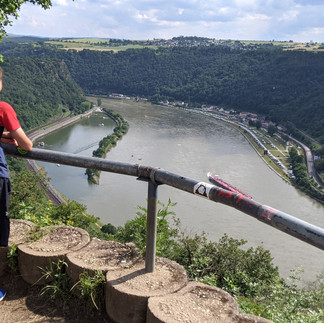Lorilie's Rock
- Jerry Griffis

- Aug 4, 2021
- 3 min read

This trip was somewhat of a necessity. After all the origin of Lorilie's name is based on this famous rock. If you are not familiar with the rock and its place on the Rhine, below is an excerpt from Atlas Obscura:
"ON THE TIP OF A causeway in the Rhine River, a 3.3-meter-tall bronze female figure watches ships go up and down the busy waterway. Sharing a name with the slate promontory towering overhead, the Loreley Statue is a relatively recent addition to the historic riverscape, and memorializes a relatively recent mythological figure borne of German Romanticism.
Since the beginning of navigation on the Rhine River, the treacherous curve under the shadow of Loreley has destroyed an untold number of ships, claiming the lives of countless sailors. While practical explanations of the perilous site chalk it up to a rocky riverbed combined with an unusual drift, 19th-century poets created a more enchanting explanation involving a river siren enticing men to their doom.
The legend involves a young woman, Loreley, with long blond hair and a beautiful voice. One version describes Loreley as a mermaid who fell in love with a human and thus came ashore from the Rhine in the form of a farmer’s daughter; another claims she was a sorceress from the nearby village of Bacharach. In either case, she fell in love with a young man who did not love her back, and thereafter sat on a rock overlooking the river, serenading it with sad songs. The beauty of both her voice and appearance was so enchanting that she caused distracted sailors to break their ships on the rocks and drown.
Like her origins, the end of Loreley’s tale also varies. One version tells of the son of a local lord (the Palsgrave, or count palatine, to be exact) who heard about the nix and wanted to see her. When he came on his ship and spotted Loreley, singing and combing her hair, he immediately fell under her spell. He attempted to go ashore to speak with Loreley but slipped, was swallowed by the river, and drowned. When the lord learned of the accident, he dispatched soldiers to capture Loreley. Fearing her power, the arresting party, upon finding her, ordered Loreley to instead jump to her death.
Apparently happy to comply, Loreley held out an amber necklace and called to the Rhine, “Father, Father, fast, fast! Send the white steeds to your child, she wants to ride with the waves and the wind.” Two rushing white waves in form of horses emerged from the Rhine and carried Loreley away with them. This is the origin of the “Father Rhine” nickname the river bears to this day.
The Loreley Statue was installed in 1983. Shipwrecks still occur at the dangerous curve, the most recent on January 13, 2011, when a tanker ship loaded with 2,400 tons sulfuric acid capsized. Thus, legends persist that the ghost of Loreley still appears—singing, combing her hair, and leading sailors to their deaths in the watery grave at the bottom of the Rhine."
Or so goes the legend....
We had to walk a ways and then ascend to the top of the rock by stairwell, a stairwell that contained the largest steps I have ever seen. It was hot and it was a little rough.

After the ascent and contemplating the connection between one of our own and the legend of the rock, we continued on the trail along the clifftops and through the surrounding forest.


















Comments